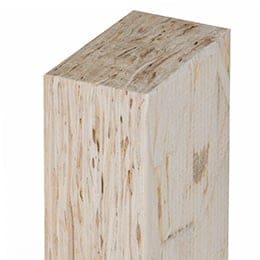Laminated Strand Lumber (LSL)
Laminated Strand Lumber (LSL) is one of the more recent structural composite lumber (SCL) products to come into widespread use. LSL provides attributes such as high strength, high stiffness and dimensional stability. The manufacturing process of LSL enables large members to be made from relatively small trees, providing efficient utilization of forest resources. LSL is commonly fabricated using fast growing wood species such as Aspen and Poplar.
LSL is used primarily as structural framing for residential, commercial and industrial construction. Common applications of LSL in construction include headers and beams, tall wall studs, rim board, sill plates, millwork and window framing. LSL also offers good fastener-holding strength.
Similar to parallel strand lumber (PSL) and oriented strand lumber (OSL), LSL is made from flaked wood strands that have a length-to-thickness ratio of approximately 150. Combined with an adhesive, the strands are oriented and formed into a large mat or billet and pressed. LSL resembles oriented strand board (OSB) in appearance as they are both fabricated from the similar wood species and contain flaked wood strands, however, unlike OSB, the strands in LSL are arranged parallel to the longitudinal axis of the member.
LSL is a solid, highly predictable, uniform engineered wood product due to the fact that natural defects such as knots, slope of grain and splits have been dispersed throughout the material or have been removed altogether during the manufacturing process. Like other SCL products such as LVL and PSL, LSL offers predictable strength and stiffness properties and dimensional stability that minimize twist and shrinkage.
All special cutting, notching or drilling should be done in accordance with manufacturer’s recommendations. Manufacturer’s catalogues and evaluation reports are the primary sources of information for design, typical installation details and performance characteristics.
As with any other wood product, LSL should be protected from the weather during jobsite storage and after installation. Wrapping of the product for shipment to the job site is important in providing moisture protection. End and edge sealing of the product will enhance its resistance to moisture penetration.
LSL is a proprietary product and therefore, the specific engineering properties and sizes are unique to each manufacturer. Thus, LSL does not have a common standard of production and common design values. Design values are derived from test results analysed in accordance with CSA O86 and ASTM D5456 and the design values are reviewed and approved by the Canadian Construction Materials Centre (CCMC). Products meeting the CCMC guidelines receive an Evaluation Number and Evaluation Report that includes the specified design strengths, which are subsequently listed in CCMC’s Registry of Product Evaluations. The manufacturer’s name or product identification and the stress grade is marked on the material at various intervals, but due to end cutting it may not be present on every piece.

For further information, refer to the following resources:
APA – The Engineered Wood Association
Canadian Construction Materials Centre (CCMC), Institute for Research in Construction
CSA O86 Engineering design in wood
ASTM D5456 Standard Specification for Evaluation of Structural Composite Lumber Products


